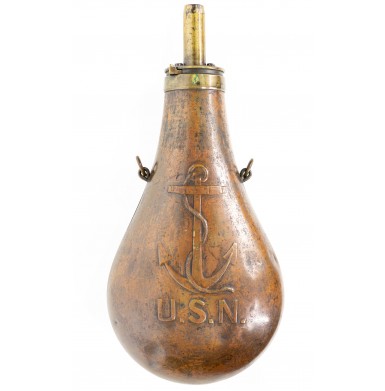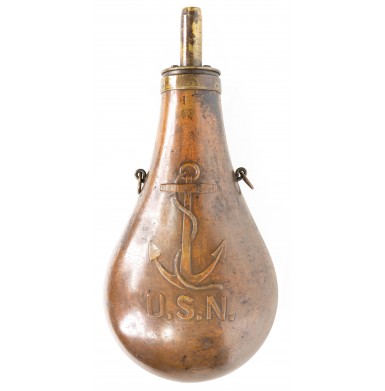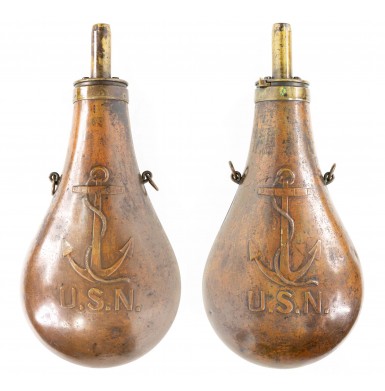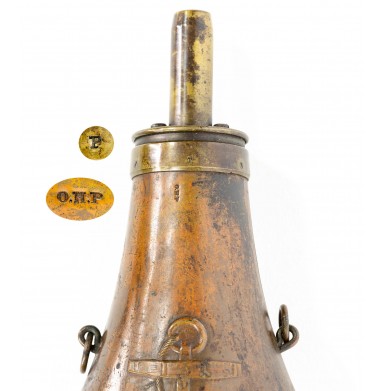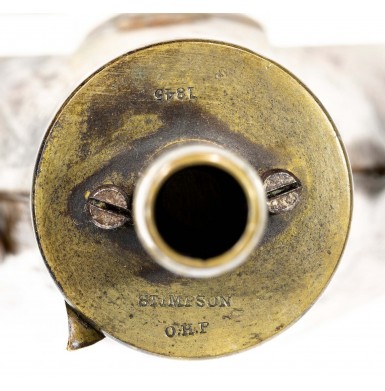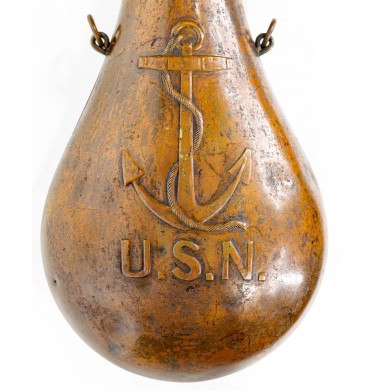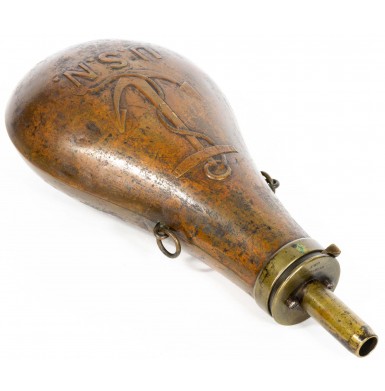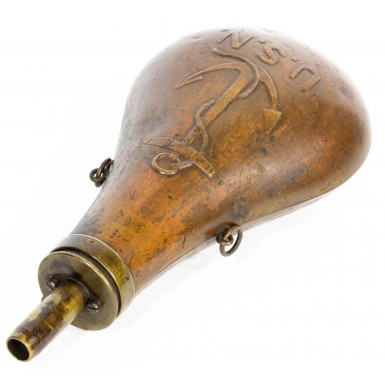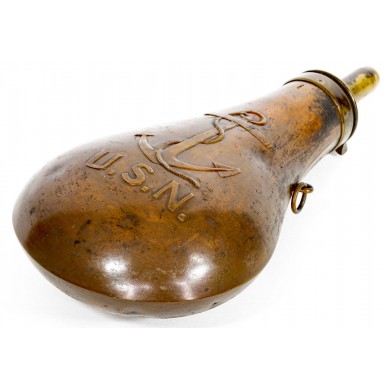Stimpson Contract "Fouled Anchor" US Navy Powder Flask
- Product Code: FPTA-GB34-SOLD
- Availability: Out Of Stock
-
$1,295.00
From the inception of the American Navy, the cow’s horn had been the container of choice for priming powder for cannons. Invariably these horns were simply a larger version of powder horn carried by nearly every owner of a muzzleloading firearm. Initially they were plugged in the same way, with a wood insert in the spout, but towards the end of the 18th century the use of the British thumb lever operated closure mechanism became more common. By the early 19th century in America the mechanically operated spout stopper was standard and except for some refinements to the wood base plug, the introduction of a threaded stopper in the butt to ease the refilling of the horn and some improvements in the slinging system, little changed for the American Naval Priming Horn from the end of the Revolutionary War to the early 1840s. However, by early 1842 the Navy was seriously considering replacing the venerable cow’s horn for priming powder with a copper flask. To that end on 24 February 1842 a letter was sent from Captain Lewis Warrington USN to Captain B. Kennon at the Washington Navy Yard. It read in part:
“The Commissioners have it in contemplation to introduce a substitute for the power horn which will be more convenient, and economical than the horn, now used in the service, and they desire you to have six copper flasks made and sent to the this office, of the shape shown in the enclosed diagram with a thumb spring, at the top, large enough to hold one pound of priming powder with a statement of their costs.”
A week later a second letter was sent from Warrington to Kennon that read in part:
“If you are making, or intend to make powder horns, the board desires you to stop all further work on them, as they wish to substitute a copper flask, in place of the horn. You will therefore consider the flask, which is made all of copper, as the pattern, allowing it to be a little flatter, and the eyes to be somewhat rounded, to prevent chaffing. Let 500 of them be made. The object of the Board, is to have a more convenient, economical and safer article, than the horn hitherto used, and they believe that the proposed flasks will be found to combine the whole of the qualifications.”
With these two letters, the origin and accurate identification of the long enigmatic NYW marked (Navy Yard Washington) and GNY (Gosport Navy Yard) powder flasks is firmly established. An examination of the two flasks, which are pictured in Ray Riling’s’ classic The Powder Flask Book as Figures 867 and 868, shows that the Washington Navy Yard flask is similar in size and profile to the well-known Naval Flasks that would follow it from Ames, Adams and Stimpson and the Gosport flask is of the type described in the second letter, as “a little flatter”. The letter clearly indicates that 500 of these flatter flasks were to be produced to replace the priming horns then in use. The Washington Navy Yard marked example was almost certainly used as the pattern to produce the small arms powder flasks that the Navy would start contracting for in 1843, initially from Ames and subsequently from Stimpson and then Adams.
The primary design difference between a priming flask for cannons and a loading flask for small arms is quite obvious. While a priming flask is covered at the end of the spout, allowing it to be opened and an unmeasured amount of powder to be poured based upon the needs of the moment, a flask for small arms must deliver a repeatable, measured charge. For the spout of a small arms flask to deliver a measured charge, the closure must be at the base of the spout. To use a small arms flask, the charging spout is covered by the thumb, the closure in the base of the spout is opened and the flask is inverted, allowing powder to fill the spout. The stopper is then released, trapping a measured charge of powder between the closure and the mouth of the spout. When the closure it as the mouth of the spout, opening it simply allows the free pouring of powder. This works fine to prime cannons but does not allow a measured charge to be dispensed for small arms. Thus, the very form of the stopper clearly indicates the flask is a priming flask and not a small arms flask.
Almost simultaneously with the adoption of the new copper cannon priming flask the Navy placed an order with the Ames Manufacturing Company for small arms powder flasks. The pattern adopted was of the traditional flask form with an embossed “fouled anchor” motif on the body of the flask and two suspension rings on the body. The flask bodies were nominally 8” tall by 5” wide with about a 1 5/8” spout, giving the flask an overall length of around 9 5/8”. Two small rings about ½” in diameter were attached to eyelets soldered to the flasks sides to allow a carrying cord or strap to be attached to the flask. The flask was designed to hold 14 ounces of powder and the fixed volume spout was intended to throw a charge of nominally 65 grains. As a 65-grain charge of powder weighs just under .15 ounces (.148571 ounces in reality), the flask carried slightly less than 100 charges, specifically 94. The flask was intended for charging the newly adopted Model 1842 Box Lock Naval Pistol as well as the Jenks Breechloading Naval Carbine both of which were being produced by the Ames Manufacturing Company. This may well have been part of the motivation to arrange for Ames to produce these flasks. All the Ames navy flasks were produced in 1843. Following the Ames contract a second contract was let to George Stimpson for naval flask and all these flasks were produced in 1845. The last contract was let to George Adams for 1,200 flasks and these were produced in 1846 and 1848. The Adams contract references the Deringer Box Lock Navy Pistol contract, suggesting these flasks were intended for use with the Deringer pistols.
Offered here is a FINE condition example of a Stimpson Contract US Navy “Fouled Anchor” Powder Flask. The flask is clearly marked on the top of the brass charging mechanism with the date 1845, along with the maker’s name STIMPSON and with the inspector initials O.H.P. These are the initials of US Navy Lieutenant Oliver H Perry, the son of the Hero of Lake Erie from the War of 1812, Oliver Hazzard Perry. Perry’s inspection initials are found on the side of the copper neck of the flask below the brass top. The edge of the brass charger’s neck is also stamped with a small P for Perry as well. The flask is in solid and complete condition and the charging mechanism remains fully functional, operating as it should. The flask shows no separations between the two copper sides nor any repairs. The copper body does show a few small dings or dents that are visible in the accompanying photos. The embossed “fouled anchor” motif remains crisp and clear on both sides of the flask, as do the letter U.S.N. that are embossed below it. The copper body has a rich ocher patina with areas of oxidized discoloration and darkness all of which give it a slightly mottled appearance that is quite attractive. The brass charging mechanism has a brighter golden appearance but also shows scattered surface oxidation and discoloration as well, both a mixture of age and old staining from the powder that was carried in the flask during the period of use. Again, the overall appearance of the brass remains quite pleasing. The flask also retains both carrying rings, attached to the eyelets on the side of the flask.
Overall, this a very nice, crisp example of the classic US Navy “Fouled Anchor” Powder Flask. It would be a fine addition to any collection of US Navy arms and accoutrements and would certainly be a great addition to a powder flask collection as well.
SOLD
Tags: Stimpson, Contract, Fouled, Anchor, US, Navy, Powder, Flask

